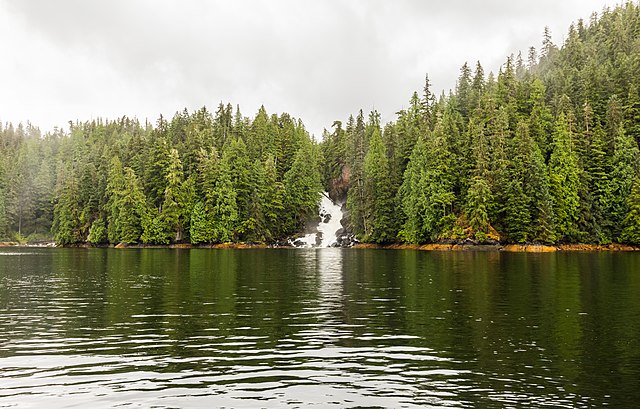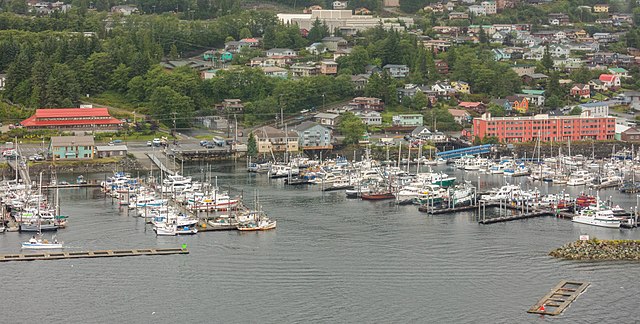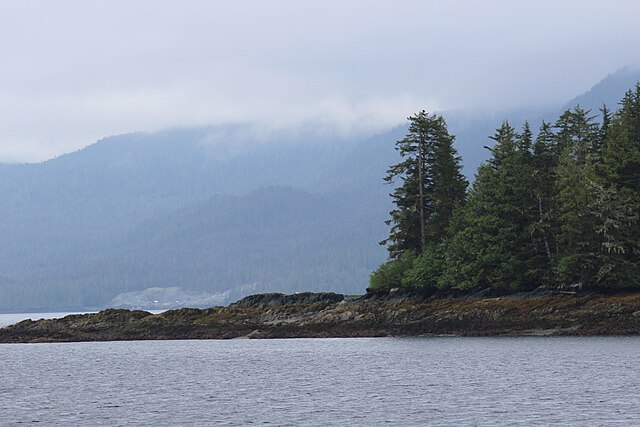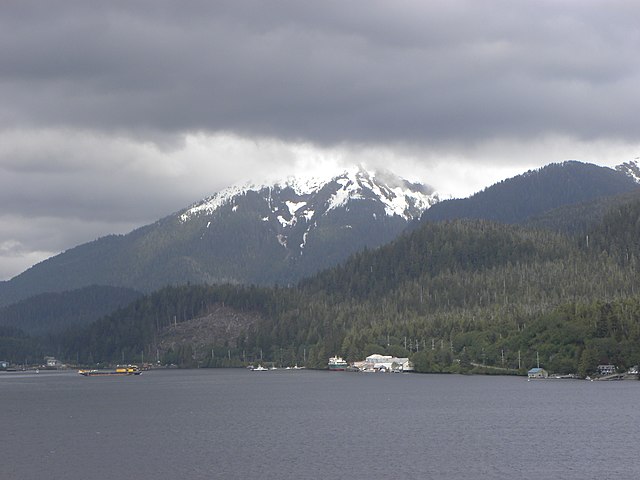Welcome to Ketchikan, Alaska, a gem tucked away in the southeastern corner of the Last Frontier. Known as the “Salmon Capital of the World,” this vibrant coastal city is where rugged wilderness meets rich cultural heritage. Ever wondered what it’s like to stroll through a rainforest, admire towering totem poles, or reel in a feisty salmon? Ketchikan’s got it all, and I’m here to take you on a journey through its misty streets, historic sites, and breathtaking landscapes. Let’s dive into what makes Ketchikan a must-visit destination!
Why Ketchikan? The Heart of Alaska’s Southeast
Ketchikan isn’t just another dot on the map—it’s Alaska’s southeasternmost city, often the first stop for cruise ships navigating the Inside Passage. With a population hovering around 8,200, it’s a tight-knit community that pulses with life. Picture a place where the ocean kisses the shore, and the Tongass National Forest, the largest in the U.S., wraps the town in a lush green embrace. Why visit? Because Ketchikan offers a taste of authentic Alaska, from its Native roots to its fishing legacy. It’s like stepping into a postcard where every corner tells a story.
A Glimpse into Ketchikan’s Geography
Nestled on Revillagigedo Island, Ketchikan stretches along the Tongass Narrows, a bustling waterway teeming with marine life. Its coordinates—55.3422° N, 131.6461° W—place it closer to Canada than most Alaskan cities. The town’s compact 5.9 square miles are dwarfed by the surrounding 17-million-acre Tongass National Forest. Imagine a city where you’re never far from a trailhead or a waterfront view. That’s Ketchikan, where nature isn’t just nearby—it’s your neighbor.
The Rain Capital: Embracing Ketchikan’s Weather

If Ketchikan had a nickname besides the Salmon Capital, it’d be the “Rain Capital of Alaska.” With an average of 153 inches of rainfall annually, it’s one of the wettest places in North America. Don’t let that dampen your spirits, though! Locals embrace the drizzle with XTRATUF boots and sturdy rain jackets. Winters hover around 35°F, milder than inland Alaska, while summers peak at a pleasant 65°F. Pack like you’re heading into a rainforest adventure, and you’ll be ready to explore, rain or shine.
How to Dress Like a Ketchikan Local
Forget umbrellas—they’re no match for Ketchikan’s gusty winds. Instead, channel your inner Alaskan with waterproof gear. A pair of XTRATUF boots, dubbed “Ketchikan sneakers,” will keep your feet dry on slick trails. Layer up with a breathable rain jacket and quick-dry pants. It’s like suiting up for a treasure hunt, where the prize is staying cozy while chasing waterfalls or spotting bald eagles.
Ketchikan’s Native Heritage: A Cultural Tapestry
Ketchikan is a living museum of Alaska Native culture, home to the Tlingit, Haida, and Tsimshian peoples. The city boasts the world’s largest collection of standing totem poles—over 80!—each one a carved masterpiece telling stories of clans, legends, and history. Visiting Ketchikan without exploring its Native heritage is like reading a book with half the pages missing. Let’s uncover the cultural gems that make this city shine.
Top Spots for Totem Pole Adventures
Start at the Totem Heritage Center, where 19th-century poles rescued from abandoned villages are preserved. It’s a window into the past, showcasing intricate carvings of ravens, whales, and bears. For a deeper dive, head to Saxman Totem Park, 2.5 miles south of downtown, where you can watch artisans at work in the carving shed. Totem Bight State Historical Park, 10 miles north, offers a scenic trail dotted with recarved poles. Each site is a storytelling session etched in cedar, waiting for you to listen.
Why Totem Poles Matter
Totem poles aren’t just art—they’re cultural archives. They mark family histories, commemorate events, or honor the departed. Unlike modern billboards, these poles speak in symbols, with each figure carrying deep meaning. Ever seen a frog atop a pole? It might represent a clan’s connection to water. Visiting these sites feels like flipping through a sacred scrapbook of Alaska’s first peoples.
Creek Street: Ketchikan’s Colorful Past
Step onto Creek Street, Ketchikan’s historic boardwalk perched on pilings above Ketchikan Creek, and you’re walking through a time capsule. Once a rowdy red-light district during the gold rush and fishing booms, it’s now a charming strip of galleries, shops, and restaurants. The pastel buildings lean over the creek like old friends sharing secrets. It’s Ketchikan’s most photographed spot, and for good reason—it’s as lively as it is nostalgic.
What to Do on Creek Street
Pop into Soho Coho, an art gallery run by local artist Ray Troll, where fish-themed prints add a quirky twist to Alaskan art. Hungry? Grab fresh salmon tacos at The Alaska Fish House. If you’re lucky, you might spot seals chasing fish in the creek below. Creek Street is like a stage where history and modern life perform a lively duet, and you’re in the front row.
Outdoor Adventures: Ketchikan’s Wild Side

Ketchikan’s backyard is a playground for adventurers. Surrounded by the Tongass National Forest and the Pacific Ocean, the city offers endless ways to get your heart racing. Whether you’re a hiker, angler, or wildlife enthusiast, Ketchikan’s got a trail, stream, or tour with your name on it. Ready to trade city streets for misty mountains? Let’s go!
Fishing in the Salmon Capital
Ketchikan’s nickname isn’t just for show—salmon run thick in its waters. Book a fishing charter to reel in king, coho, or pink salmon. Local guides know every hot spot, from Clover Pass to Knudson Cove. It’s like a treasure hunt, but instead of gold, you’re hauling in a 20-pound fish. Even beginners can land a keeper, and many charters will fillet your catch for dinner. Nothing beats grilling your own salmon under the Alaskan sky.
Pro Tip for Anglers
June and July are prime salmon season, but don’t sleep on halibut or cod for a different challenge. Bring a cooler to ship your catch home—your friends will thank you for the freshest fish they’ve ever tasted. Fishing here isn’t just a sport; it’s a rite of passage.
Hiking Trails for Every Level
Lace up your boots and hit trails like Deer Mountain, a 3-mile climb with panoramic views of the narrows. For a gentler stroll, try the Rainbird Trail, a 1.3-mile path through mossy forest. Each trail feels like a secret passage into Middle-earth, with ferns, cedars, and maybe a black bear or two (keep your distance!). Ketchikan’s trails remind you why Alaska’s nickname is the Last Frontier.
Wildlife Watching: Eagles, Whales, and More
Ketchikan’s wildlife is as bold as its scenery. Bald eagles soar overhead, their white heads glinting against the gray sky. Take a boat tour to spot humpback whales breaching or orcas slicing through the waves. On land, keep an eye out for black bears foraging in the forest. It’s like starring in your own National Geographic episode, with every outing a chance to see something wild.
Best Wildlife Tours
Book a Misty Fjords National Monument tour by floatplane or boat for jaw-dropping views of cliffs, waterfalls, and marine life. Closer to town, Herring Cove is a hotspot for bear sightings during salmon runs. Bring binoculars and a camera—your Instagram will thank you. These tours aren’t just trips; they’re front-row seats to nature’s greatest show.
Ketchikan’s Food Scene: Fresh and Flavorful
Ketchikan’s culinary scene is as fresh as it gets. With the ocean at its doorstep, seafood reigns supreme. From food trucks to fine dining, the city serves up dishes that capture Alaska’s essence. Ever tried crab so fresh it was swimming hours ago? Ketchikan’s restaurants deliver that and more.
Where to Eat in Ketchikan
For upscale dining, Cape Fox Lodge offers salmon with a view of the narrows. Craving casual? Bar Harbor Ale House serves hearty burgers and local brews. Don’t miss Annabelle’s Keg and Chowder House for creamy clam chowder in a historic setting. Each bite feels like a love letter to Alaska’s bounty.
History and Industry: Ketchikan’s Roots

Ketchikan’s story is one of resilience. Founded by Native peoples, it grew into a hub for fishing, logging, and mining in the late 19th century. The city’s shipyard, one of the most modern in the U.S., keeps its maritime legacy alive. Walking through Ketchikan feels like flipping through a history book, with each building whispering tales of boom and bust.
Exploring Historic Sites
Visit the Southeast Alaska Discovery Center to learn about the Tongass Forest and Ketchikan’s industries. The Yates Memorial Hospital, a 1905 mission house turned medical facility, is a National Trust for Historic Preservation site. These landmarks are like time machines, pulling you into Ketchikan’s rugged past.
Getting to Ketchikan: Your Travel Options
Ketchikan’s island location means you’ll arrive by air or sea. Fly into Ketchikan International Airport, a short ferry ride from downtown, or sail in via the Alaska Marine Highway System. Cruise ships dock right in the heart of town, making exploration a breeze. It’s like the world conspires to drop you into this Alaskan paradise.
Ketchikan is walkable, with most attractions within a mile of downtown. Rent a bike for longer jaunts or hop on a local bus. Taxis and shuttles are plentiful during cruise season. Getting around is as easy as following the salmon upstream—just go with the flow.
Events and Festivals: Ketchikan’s Community Spirit
Ketchikan’s calendar is packed with events that showcase its spirit. The Blueberry Arts Festival in August blends art, music, and berry-themed treats. The Great Alaskan Lumberjack Show is a crowd-pleaser, with axe-throwing and log-rolling. These events are like a big Alaskan hug, welcoming visitors into the fold.
Conclusion: Why Ketchikan Steals Your Heart
Ketchikan, Alaska, is more than a destination—it’s a feeling. From its misty rainforests to its vibrant totem poles, this city weaves a spell that lingers long after you leave. Whether you’re fishing for salmon, hiking through the Tongass, or savoring fresh crab, Ketchikan delivers an authentic slice of Alaska. It’s a place where nature, culture, and history collide in the best way possible. So, pack your rain gear, book that trip, and let Ketchikan show you why it’s the heart of the Last Frontier. What are you waiting for?
Frequently Asked Questions
1. What’s the best time to visit Ketchikan, Alaska?
Summer (May to September) is ideal for mild weather, long daylight hours, and peak salmon fishing. June and July are busiest, so book early for tours and lodging.
2. How much rain does Ketchikan really get?
Ketchikan averages 153 inches of rain annually, so expect drizzle most days. Embrace it with waterproof gear, and you’ll enjoy the lush scenery that comes with it.
3. Are there bears in Ketchikan?
Yes, black bears are common in the Tongass National Forest. Stick to marked trails and join guided tours for safe wildlife viewing, especially at Herring Cove.
4. What’s the deal with Ketchikan’s totem poles?
Ketchikan has over 80 totem poles, the world’s largest collection. They’re carved by Tlingit, Haida, and Tsimshian artisans, symbolizing clan stories and heritage.
5. Can I visit Ketchikan without a cruise?
Absolutely! Fly into Ketchikan International Airport or take the Alaska Marine Highway ferry. The city’s walkable downtown makes it easy to explore independently.

